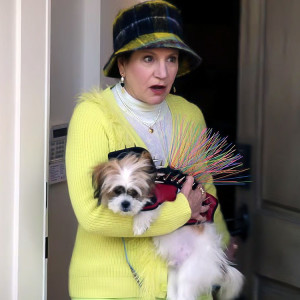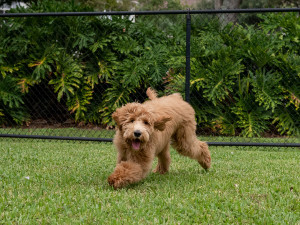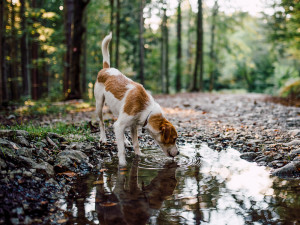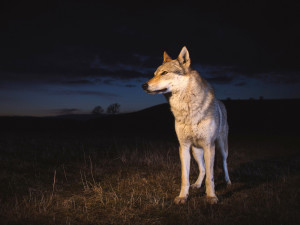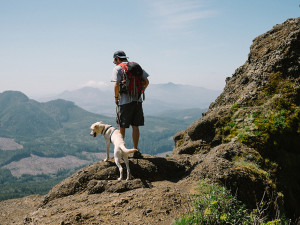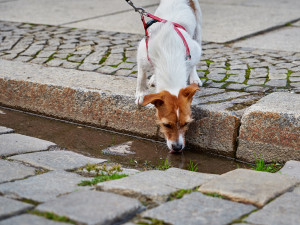How to Protect Your Dog From Coyote Attacks
Social media influencer Ashley Yi’s dog was killed by a coyote. Here are some tips for keeping your pup safe.
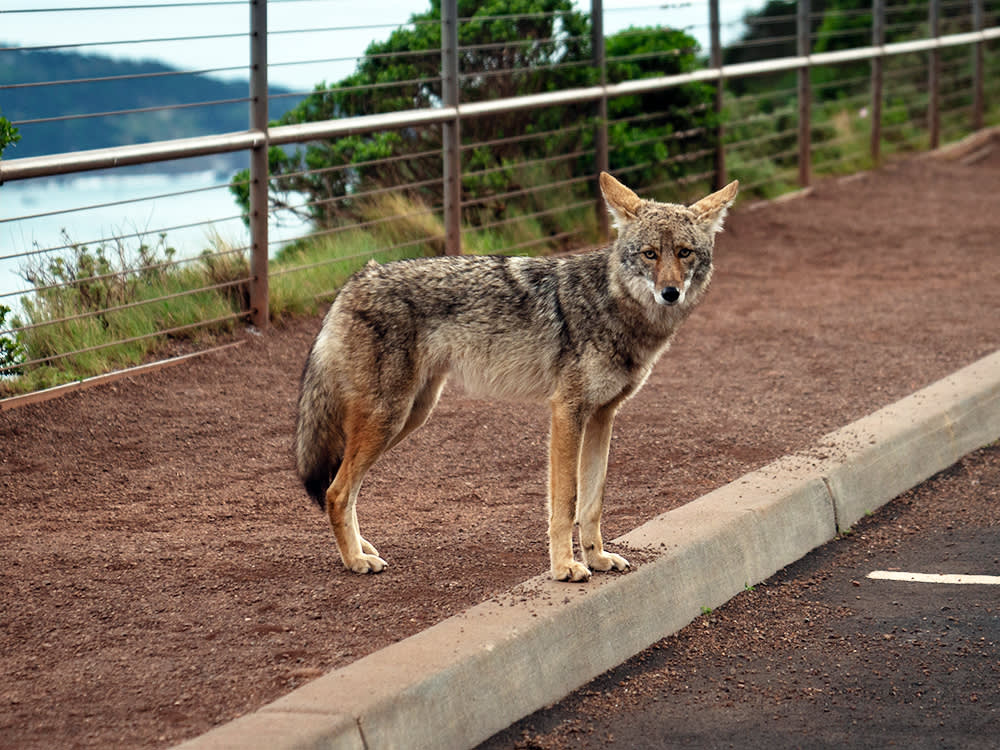
Share Article
On Saturday, Aug. 17, social media influencer Ashley Yi, also known as @ashyizzleopens in a new tab, posted a TikTok video explaining that her Pomeranian, Nimbus, was attacked and killed by a coyote two weeks ago.
“My father carelessly left Nimbus in the backyard at night, unsupervised, with the doors closed,” she shared. She added that she had warned her dad about the dangers of coyotes.

littleKin™ is Kinship’s home just for puppy and kitten parents. Bop over to check out expert advice, new pet tools, and special deals—all curated for your newest family member.
opens in a new tab“I have never felt so angry, devastated, and defeated in my life,” Ashley continued in the video. “My best friend, my son, the one thing I cherish the most in my life, died scared and in pain. All my father had to do was stand outside for five minutes.”
And Yi was right to be concerned. She lives in Los Angelesopens in a new tab, where coyotes are a huge threat to dogs — especially small ones. In the past, coyotes were often encountered by those near wildlife reserves, forests, or farms — but that’s now changing. Now that more people work from home, wildlife spottings in urban areas, like LA, are pretty common. This is why coyote vestsopens in a new tab are so crucial as an extra piece of literal armor to protect your pup from this danger.
But what do you do when you do see one? First off, it’s very important that you are supervising them at all times in an area where coyotes may be lurking. It’s equally necessary that you watch your dog’s body language for signs that they see something dangerous, because they will probably notice the coyote first.
If spotted in the distance, dogs will naturally raise their hacklesopens in a new tab and may show that they are in distress when confronted with a coyote. Most dogs will bark and enter a sort of protective mode, letting the coyote know to keep their distance. Then what?
Let’s start with the coyote basics.
Coyotes are incredibly beneficial to the natural ecosystem. As omnivores, coyotes are cities’ top predators, also known as “nature’s clean-up crew,” reducing the population of rodents and scavenging on dead animals.
The Eastern Coyote, North America’s “Song Dog,” shares common DNA opens in a new tabwith the Algonquin Wolf. When left unhindered to thrive on their own, coyotes mate for life and have significant family bonds. Each family of coyotes maintains and defends a territory or home range that averages between five and 28 square kilometers (three to 18 square miles), depending on food availability. They are skillful foragers who make use of a range of natural and human discarded food and waste.
Should you be scared if your dog barks at a coyote?
Dogs can smell and communicate with wildlifeopens in a new tab, including coyotes, via howling, barking, whimpering, sniffing, eye contact, and body language. Barking can pique a coyote’s interest, though the sound is more likely to scare a coyote away after they notice a human presence.
In one studyopens in a new tab, published in 2018, researchers found some coyote and dog interactionsopens in a new tab were positive, almost downright playful, but they also found just as many coyote interactions that were predatory or involved lunging or biting. You should never, ever take the risk. If your dog seems interested in the coyote, distract them with treats or change direction to reduce interaction and communication, preventing further escalation.
It is super important that you make sure your dog does not chase a coyote — these canines see chasing differently. Keeping a large distance between you, your dog, and the coyote helps minimize the potential for confrontation and makes negative interactions more difficult.
If you notice coyotes in your neighborhood, do the following:
Reach out to your local fish and wildlifeopens in a new tab department for assistance if you notice an uptick in coyotes in your neighborhood. Depending on the family of coyotes, intensive and consistent action may be required to encourage them to move entirely. With that being said, the high-intensity hazing of a coyote family should only be conducted by trained professionals with first-hand experience in advanced techniques.
What should you do if a coyote is approaching you and your dog?
First and foremost, remain calm, keep eye contact, and slowly back away while leaving the area. Never run from a coyote, as you may trigger their predatory response and give it a reason to chase you. If you have any personal alarm devices, such as a whistle, bell, or phone alarm, use them to scare the coyote.
Stop and stand still.
Make yourself big.
Be loud and assertive.
Slowly back away.
Never turn your back and run.
Your goal is to deter the coyote from approaching.
If you see a coyote on your walk, there are some things you can do to help discourage coyotes from hanging around. Aversive trainingopens in a new tab is something you should avoid when training your dog, but when it comes to coyotes, aversion conditioning is a must. Aversion conditioning is the process by which an unpleasant stimulus is paired with undesirable behavior. Using aversive techniques can restore a coyote’s natural avoidance of humans and minimize direct interactions.
Think about how you can appear larger than life.
Standing tall, making yourself look big, waving your arms, and shouting (but not screaming) while walking in the direction of the coyote until they run away. Use a noisemaker such as your voice, a whistle, an air horn, banging pots and pans, filling a soda can with rocks, and shaking it, or snapping a large garbage bag, jingling keys, etc. These can all be very effective.
Always keep a safe distance.
With coyotes that are accustomed to these aversive techniques, it may take more than one of the above deterrents. If the coyote continues to approach, back away while facing the coyote and maintaining eye contact. If the coyote displays aggressive behavior, remember to make yourself look big by raising your hands, stomping your feet, shaking your jacket, and making noise while shouting, “Go away!”
Be threatening.
In the rare case that the coyote decides to continue to approach you, throw rocks or sticks in their direction but try not to hit the coyote. Your goal isn’t to injure them, simply to scare them. Sticks, clumps of dirt, or tennis balls work well. Keep in mind that if you are walking with a small dog or your child, pick them up in your arms, giving the coyote less reason to continue to approach.
How to prevent encounters with coyotes
Clean up attractants.
Bird feeders around the house attract rodents and small mammals, thus attracting coyotes, foxes, and birds of prey. Be sure to clean any fallen food or fruit from fruit treesopens in a new tab. Do not leave pet food outside as it will attract unwanted wildlife. If you feed feral cats, leave food out for 30 minutes, then remove it. Keep all garbage in secured compost bins.
No unsupervised roaming.
Resist the urge to let your pets roam without supervision. Be sure to go outside with your dog at night to supervise them while they do their business. Coyotes and other wildlife can sneak into backyards for a meal.
Give wildlife their deserved space.
When you are out and about with your pup, or even at home, remember to give animals their space. Whether it is a squirrelopens in a new tab, rabbit, or coyote, teach your dog to respect and not harass or chase wildlife.
Keep your property clean.
Remove big brush piles as they provide a perfect hiding spot for predators. Scoop your pup’s poop as pet feces attract rodents, which attract larger wildlife. Keep all outdoor cooking areas clean.
Avoid certain walking hours.
Coyotes are most active during the hours of sunrise and sunset; be sure to keep your eyes open and be aware of your surroundings.
Remember that each animal on this earth plays a big role in the healthy maintenance of the natural ecosystems and the circle of life everyone depends on; we need them as much as they need us. Coyotes are a part of your urban communityopens in a new tab and will probably remain that way, so keep your eye out and give them plenty of space.
References:
Canid vs. Canid: Insights Into Coyote–Dog Encounters From Social Mediaopens in a new tab

Nicholas Mozas, M.Sc.
Nicholas Mozas is a graduate of the University of Guelph in Biological Science and holds an M.Sc. in Neutragenomics. Nicholas managed an Animal Hospital after graduation, gaining a better understanding of pets’ and owners’ needs. He is also the founder and CEO of DOGORA.
Related articles
![Dog Drinking Water From A Pond In The Nature]() opens in a new tab
opens in a new tabVets Issue A Warning After Two Dogs In Missouri Pass Away From Leptospirosis
The deadly disease is most common in autumn and late summer. Find out how to keep your pup safe.
![Hybrid Czechoslovakian Wolfdog rescue sanctuary]() opens in a new tab
opens in a new tabWolfdog Sanctuaries Are Stressed
Ownership of wolf-dogs is on the rise putting animals are in danger.
![A man with a dog on a hike stoping to enjoy a beautiful overlook on a cliff.]() opens in a new tab
opens in a new tabHow to Take Silly Little Mental Health Hikes With Your Dog
It’s good for you both — promise.
![Dog drinking water from a puddle in the road]() opens in a new tab
opens in a new tabGiardia in Dogs: Signs, Symptoms and Treatment of This Parasite
If your dog drinks from puddles or splashes around in lakes, read this.
